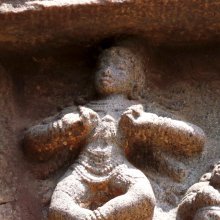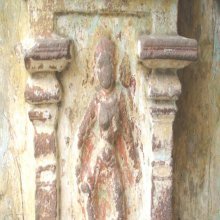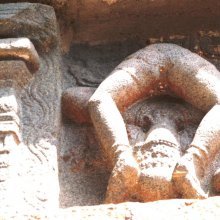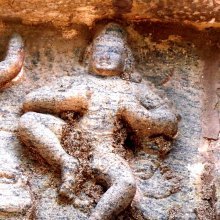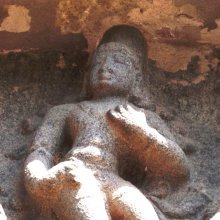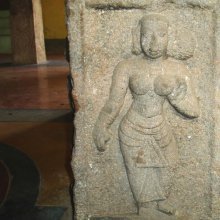Movement: 2 definitions
Introduction:
Movement means something in Hinduism, Sanskrit. If you want to know the exact meaning, history, etymology or English translation of this term then check out the descriptions on this page. Add your comment or reference to a book if you want to contribute to this summary article.
Images (photo gallery)
(+108 more images available)
In Hinduism
Natyashastra (theatrics and dramaturgy)
Source: Shodhganga: Elements of Art and Architecture in the Trtiyakhanda of the Visnudharmottarapurana (natya)Movements of the Entire Body (in Sanskrit Dramas) are denoted by the Sanskrit term Ceṣṭākṛta and they are conveyed through Āṅgikābhinaya: one of the four divisions of Abhinaya or “ways to convey or represent one’s emotion to others”, according to the Nāṭyaśāstra and the Viṣṇudharmottarapurāṇa, an ancient Sanskrit text which (being encyclopedic in nature) deals with a variety of cultural topics such as arts, architecture, music, grammar and astronomy.—The āṅgikābhinaya includes the histrionic representation of the limbs which is simply known as physical gestures. In the Nāṭyaśāstra, three kinds of physical gestures are accepted. The gestures expressed with major classification of the body parts are termed as: śarīra i.e., physical expression, mukhaja i.e., facial expression and ceṣṭākṛta i.e., different movements of the entire body.

Natyashastra (नाट्यशास्त्र, nāṭyaśāstra) refers to both the ancient Indian tradition (shastra) of performing arts, (natya—theatrics, drama, dance, music), as well as the name of a Sanskrit work dealing with these subjects. It also teaches the rules for composing Dramatic plays (nataka), construction and performance of Theater, and Poetic works (kavya).
Yoga (school of philosophy)
Source: ORA: Amanaska (king of all yogas): A Critical Edition and Annotated Translation by Jason Birch1) Movement can be denoted by the Sanskrit terms Cala, according to the Amanaska Yoga treatise which deals absorption, yogic powers and liberation.—The Amanaska referred to (or qualified) Samādhi with several terms, which are all negative; [e.g., acala—it has no movement;] [...] The fact that such terminology is found in the Amanaska indicates that descriptions of Śiva and the void-like meditative states in Mantramargic Śaivism, were the basis of the descriptions of Samādhi and Paratattva (the highest reality) in this treatise. The Amanaska Yoga was consistent with the Pātañjala Yogaśāstra’s definition of Yoga, yet it described Samādhi in terms different to those of Pātañjalayoga; such as “that which has no movement” (acala).
2) The Movement (of the breath) is denoted by the Sanskrit term Spanda, according to the Haṭhapradīpikā of Svātmārāma: an influential 15th-century Sanskrit manual on Hatha-Yoga dealing with techniques to channel one’s vital energy.—Accordingly, while discussing methods for conquering the mind: “Acquiring spiritual knowledge, associating with the wise, abandoning habitual tendencies and stopping the movement (spanda) of the breath; according to tradition, [all] these methods are effective in conquering the mind. The [mind] is quickly overcome by these [methods of restraint] like the dust of the earth by streams [of water]”.

Yoga is originally considered a branch of Hindu philosophy (astika), but both ancient and modern Yoga combine the physical, mental and spiritual. Yoga teaches various physical techniques also known as āsanas (postures), used for various purposes (eg., meditation, contemplation, relaxation).
See also (Relevant definitions)
Ends with: Delicate movement, Dhammakaya Movement, External movement, Forceful movement, Internal movement, Physical movement, Steady movement.
Full-text (+2204): Samcara, Bhujangatrasita, Diksvastika, Ghurnita, Grahagati, Nagapasarpita, Recita, Mattakrida, Sthirahasta, Ceshtakrita, Vikshipta, Lalatatilaka, Tiryagvalana, Mandalasvastika, Nikuttaka, Gandasuci, Kalasike, Ceshta, Katisama, Talasamghattita.
Relevant text
Search found 363 books and stories containing Movement; (plurals include: Movements). You can also click to the full overview containing English textual excerpts. Below are direct links for the most relevant articles:
Vakyapadiya of Bhartrihari (by K. A. Subramania Iyer)
Verse 2.20-21 < [Book 2 - Vākya-kāṇḍa]
Verse 1.49 < [Book 1 - Brahma-kāṇḍa (or Āgama-samuccaya)]
Verse 1.122 < [Book 1 - Brahma-kāṇḍa (or Āgama-samuccaya)]
Vishnudharmottara Purana (Art and Architecture) (by Bhagyashree Sarma)
1.3. Elements of Drama (c): Bodily Movements < [Chapter 3 - Drama and Dance]
2.4. Cārī (delicate movements of limbs) < [Chapter 3 - Drama and Dance]
1.3. Elements of Drama (e): Gatiprasāra (gait extension) < [Chapter 3 - Drama and Dance]
Vipassana Meditation (by Chanmyay Sayadaw)
Part 5 - Silent Awareness < [Chapter 2 - Preliminary Instructions For Meditators]
Part 2 - Mindfulness Of The Four Elements < [Chapter 2 - Preliminary Instructions For Meditators]
Part 4 - Purification By Overcoming Doubt < [Chapter 5 - The Seven Stages Of Purification]
Gati in Theory and Practice (by Dr. Sujatha Mohan)
Manifestation of Gati in Cārīs and Karaṇas (Introduction) < [Chapter 2 - Concept and technique of Gati]
Gati in classical form of Mohiniāṭṭam < [Chapter 4 - Practice of Gati]
Performance of Cārī < [Chapter 2 - Concept and technique of Gati]
Vipassana Meditation Course (by Chanmyay Sayadaw)
Part 2 - The Noble Eight-fold Path < [Chapter 4 - Excercises In Mindfulness]
Part 3 - Sitting Meditation < [Vipassana Meditation Guidelines]
Nitiprakasika (Critical Analysis) (by S. Anusha)
Gadā (Mace) < [Chapter 3]
Mauṣṭika (Fist Sword, Dagger) < [Chapter 3]
Movements in a Vyūha < [Chapter 4]
Related products
(+46 more products available)
